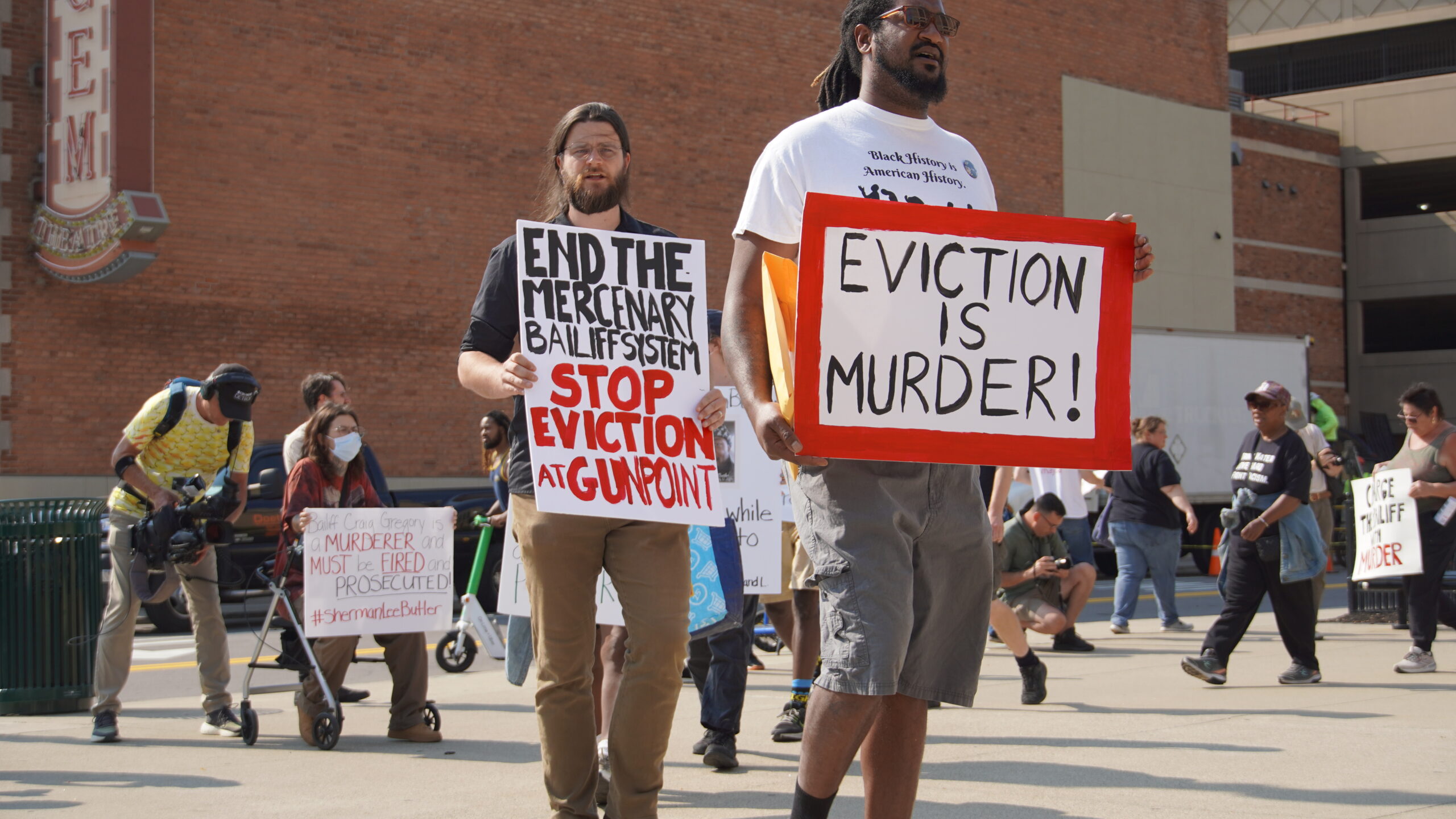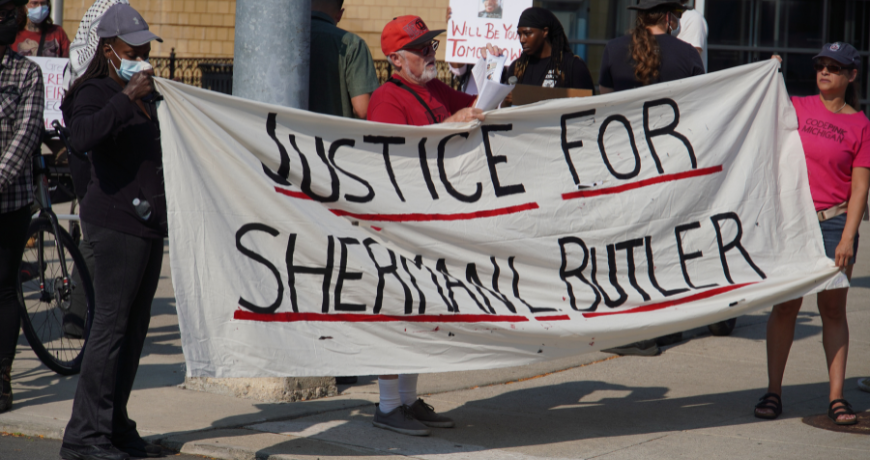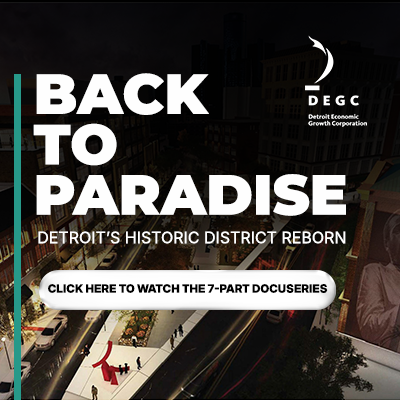Grabbing a pack of Skittles and iced tea while Black, driving while Black, running while Black, in your home while Black, defending yourself while Black, playing at the park while Black, calling for help while Black, being evicted while Black…
The tragic and unfair loss of Black life is an ongoing issue that is increasingly prevalent, congruently occurring alongside the ever-expanding list of daily tasks and responsibilities that cause Black individuals to be unjustly killed by law enforcement. As Detroit continues to grapple with issues of public safety, concerns over the effectiveness and impact of community policing strategies are growing.
In front of the 36th District Court, approximately 50 community leaders, residents, and advocacy groups voiced their worries that the current policing model may not address honest, deeper, systemic issues that adequately foster trust between law enforcement and the neighborhoods they serve.
The recent community outrage sparked a protest following the murder of Sherman Lee Butler by a 36th District Bailiff on July 12, 2024, at the Palmer Park apartments. It’s been more than a month, and the community demands that the bodycam footage be released, calling for transparency and accountability from the City of Detroit and the Police Department.
Tristan Taylor, founder of Detroit Will Breathe, expressed during Wednesday’s protest that the march and rally were to demand justice and accountability.
“We want justice for Sherman Lee Butler, a person who was having a mental health crisis in the middle of the eviction process, a process that is hard on anybody, and who ended up dead,” Taylor expressed.
“He was killed by a bailiff, a TASER, by a police officer who couldn’t wait for the mental health unit that they created to come and de-escalate the situation.”
Lack of Trust, Transparency, and Accountability
One of the core concerns is the perception that community policing has not bridged the gap between officers and residents in neighborhoods that have long faced over-policing, racial profiling, and a lack of economic investment. Communities, particularly those of color, often express distrust toward the police, citing instances of excessive force and inadequate responses to local concerns. Despite initiatives to increase police presence in neighborhoods, many feel that law enforcement still lacks transparency and accountability.

According to Statista Research in the United States, between 2005 and 2020, of the 42 nonfederal police officers convicted following their arrest for murder due to an on-duty shooting, only five ended up being convicted of murder. The most common offense these officers were convicted of was the lesser charge of manslaughter, with 11 convictions.
Community Calls for Training and Cultural Sensitivity
Another critical concern revolves around the training and cultural competency of officers assigned to community policing. Community advocates argue that officers are often ill-prepared to handle the complex, culturally diverse neighborhoods of Detroit, which can lead to misunderstandings and miscommunication. They call for a greater emphasis on de-escalation training, anti-bias education, and programs encouraging officers to develop stronger ties with the neighborhoods they serve.
“The main result is to ensure that we’re all going to fight for justice, to expose the flaws and contradictions that we heard from DPD, who are at this point disregarding their own policy of releasing body count footage, allowing the citizens to review and see what took place,” Taylor expressed.
“This is very opposite of police accountability, especially when DPD is also ignoring the board of police commissioners who have voiced concern and interest in seeing the video released to the public.”
Balancing Public Safety and Civil Rights
A recurring concern among community members is balancing enhancing public safety and respecting civil liberties. Some Detroiters fear that community policing might be a guise for increasing surveillance in their neighborhoods, with officers stationed in communities as a preventative measure rather than as true partners in solving local problems. This fear is heightened by Detroit’s use of advanced technologies, like facial recognition software, which has sparked debates about privacy and racial profiling.
In January 2020, the Detroit police made a wrongful arrest when they apprehended Robert Williams outside his residence in front of his two young daughters and wife and in full view of his neighbors. This case was notable as it was the first publicly reported incident where a false face-recognition “match” resulted in the wrongful arrest of an individual. Subsequently, the City of Detroit reached a settlement regarding this matter.
10 Years Post-Mike Brown’s Murder in Ferguson
Ten years ago, on August 9, 2014, the killing of 18-year-old Michael Brown by a Ferguson police officer ignited a national firestorm, laying bare the brutal realities of systemic racism and police violence in Black communities across America. The shooting, which galvanized the Black Lives Matter movement, marked a turning point in the fight for justice, forever altering the landscape of race relations in cities nationwide.
In Detroit, Ferguson served as a wake-up call, leading to increased activism and community organizing. Local organizations like Detroit Will Breathe is one of those organizations leading the charge and began pushing for police reform, advocating for civilian oversight of the police department, and demanding greater transparency and accountability.
The city’s history of racial tension and police violence added urgency to these efforts, as residents saw Ferguson as both a reflection of their own experiences and a warning of what could happen if change didn’t come.
Detroit Will Breathe activist Allen Dennard is concerned that instances of police brutality are on the rise and showing no signs of improvement.
“Police reforms, and since Mike Brown and Ferguson, having done my research between 2013 and 2023, there have been over 1000 police killings, and 2020 was when George Floyd happened. The police killings have only increased, actually. So reform, supposed reform, has done nothing but only enhance police brutality. So I see us taking steps back from what we imagine public safety to be, ” Dennard said.
Ferguson: A Catalyst for Change
Ferguson, a small suburb of St. Louis, became the epicenter of protests, civil unrest, and demands for accountability after Mike Brown was killed. The image of Brown’s body lying in the street for hours, coupled with conflicting reports about the circumstances leading to his death, resonated with African American communities who had long faced similar struggles.
The shooting brought national attention to the longstanding tensions between law enforcement and Black residents, leading to an investigation by the Department of Justice (DOJ) into the Ferguson Police Department. The findings revealed a pattern of racial bias and discrimination, resulting in a consent decree to reform the department.
The Impact on Black Cities Across America
The events in Ferguson reverberated across Black cities in America, serving as a grim reminder of the persistent inequality and violence faced by African Americans. Cities like Detroit, Baltimore, Chicago, and New York saw their own communities rally in solidarity, using Ferguson as a rallying cry for their struggles against police violence and systemic injustice.
Evan Villeneuve, who is also an activist with Detroit Will Breathe, emphasized that the county is currently seeing a disturbing trend in the number of police killings of Black individuals.
“Are we better off than we were 10 years ago in terms of police policing in the United States? No, we are not. It also depends on what you define as better,” Villeneuve said.
“But if you just want to talk about it from a statistical standpoint, a simple statistic of the amount of people that are being killed by the police, specifically, mostly black people. We are not anywhere near any margin of progress.”
Moving Toward a Safer Detroit
While community policing remains a divisive issue in Detroit, it’s clear that without meaningful reforms and an emphasis on trust-building, tensions between law enforcement and neighborhoods will persist. The push for more inclusive strategies, culturally competent training, and greater transparency is crucial to reshaping how public safety is achieved in the city.
As Detroit moves forward, it faces the challenge of balancing effective crime prevention with the protection of civil rights—ultimately determining how policing can genuinely serve its residents.
Dennard expressed a need to see a revival of unity within the black community. Something that the community doesn’t see, however, only seeing the violent side of Black people.
“We (Black people) are violent by our environment, by our poverty. You don’t see Bloomfield Hills and Birmingham being violent because they have resources, they have quality education, and they have housing that they can afford because they were set up with great opportunities that we, as Black people, never got a chance to have,” Dennard said.



